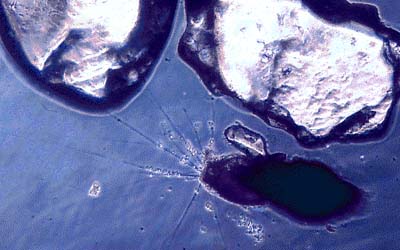







Most of the estimated 4,000 living species of forams live in the world's oceans. Of these, 40 species are planktonic, that is they float in the water. The remaining species live on the bottom of the ocean, on shells, rock and seaweeds or in the sand and mud of the bottom. In places, foraminifera are so abundant that the sediment on the bottom is mostly made up of their shells. For example, the pink sands of Bermuda get their color from the shells of a foraminiferan called Homotrema rubrum which has pink to red-colored shells. Far from land in the deep sea, where little material comes from erosion of the land, the bottom sediment is made up mainly of shells of planktonic organisms, especially foraminifera.
Foraminifera are found in all marine environments, from the intertidal to the deepest ocean trenches, and from the tropics to the poles, but species of foraminifera can be very particular about the environment where they live. Some are abundant only in the deep ocean, others are found only in brackish estuaries or salt marshes along the shore, and most live at certain depths and water temperatures in between.

Foraminifera are an important part of the marine food chain. On the continental shelf there can be tens of thousands of living individuals per square meter of ocean bottom. Many larger animals (including snails, sand dollars, and fish) eat forams, and some are very selective about which species they eat.
Because different species of foraminifera are found in different environments, paleontologists can use their fossils to determine past environments. If a sample of fossil foraminifera contains many living species, the present-day distribution of those species can be used to infer the environment there when the fossils were alive. Even when samples contain all or mostly extinct species, data such as species diversity, the relative numbers of planktonic and benthic species (planktic:benthic ratio), and the ratios of different shell types are used to infer past environments.
In addition to using species distributions (whether directly or through diversity and other ratios) to study past environments, the chemistry of the shell can tell us about the chemistry of the water in which it grew. Most importantly, the ratio of stable oxygen isotopes depends on the water temperature, because warmer water tends to evaporate off more of the lighter isotopes. Studies of stable oxygen isotopes in planktonic and benthic foram shells from hundreds of deep-sea cores worldwide have been used to map past water temperatures. These data help us understand how climate has changed in the past and thus how it may change in the future.


